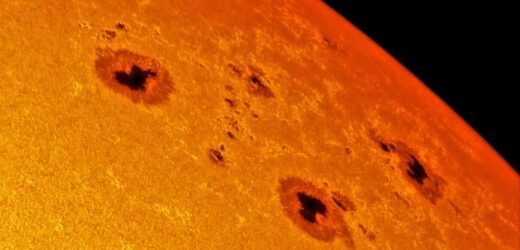NASA Solar Observatory captures solar flares in October
We use your sign-up to provide content in ways you’ve consented to and to improve our understanding of you. This may include adverts from us and 3rd parties based on our understanding. You can unsubscribe at any time. More info
The three sunspot swarms, or “active regions”, have been given the designations AR2993, AR2994 and AR2995. Each swarm contains several individual sunspots, regions of the Sun’s surface that appear darker and cover hundreds of millions of square miles — far larger than the Earth’s diameter. They are caused by magnetic disruptions in the photosphere, the lowest layer of the Sun’s atmosphere, with these disturbances exposing the cooler layers of the star underneath.
The Sun’s activity tends to follow 11-year-long cycles, with solar activity in each building to a peak, during which the star’s magnetic poles flip, followed by a ramping down period before the next cycle begins.
Astronomers began numbering the solar cycles in 1775 — when extensive monitoring of solar activity first began — and we are presently in Solar Cycle 25.
Cycle 25 has yet to reach its peak, meaning that increasing levels of solar activity can be expected over the next couple of years until the poles flip in late 2024 or early 2025.
Solar physicist Dean Pesnell of NASA’s Goddard Space Flight Center in Maryland told Live Science: “I’m sure we shall see larger [active regions] over the next few years.
“Active regions 2993 and 2994 are middling in size and don’t represent the best that Solar Cycle 25 can produce.”


Energy can be released from the Sun’s active regions in the form of both solar flares — sudden flashes of radiation — and so-called coronal mass ejections, or CMEs.
The latter, one of the most powerful forms of solar storm, manifests as a belched-out cloud of charged particles and electromagnetic fluctuations.
If sufficiently large, such storms have the potential to wreak havoc on the Earth, inducing fluctuations in the power grid, disrupting high-frequency radio signals and interfering with satellite operations in low-Earth orbit.
The most severe geomagnetic storm on record — the so-called “Carrington Event” — occurred in the wake of CME in the September of 1859.


The Carrington Event affected telegraph networks across Europe and North America, as well as the recently-lain transatlantic link that connected them.
Currents generated in cables by the space weather event reportedly caused telegraph pylons to spark, operators to receive electric shocks and some lines to fail completely.
Other lines, meanwhile, were found to still operate even once their power had been cut, so strong were the electrical currents induced by the storm.
While we are unlikely to see another Carrington Event in the present solar cycle, which is relatively weak, the last few days have seen the emission of a number of large solar flares.
The latest, which was detected by Earth-orbiting satellites at 01:57 BST this morning, was an M9.6 class flare released from the AR2993 and AR2994 complex, which at present is almost directly facing the Earth.
DON’T MISS:
Google Maps exposes Putin as ‘ALL’ of Russia’s military bases spotted [REPORT]
Putin unleashes fury at EU as pipeline to go dry in just days [INSIGHT]
EU tries to bully Britain with ultimatum for UK-based scientists [ANALYSIS]

The radiation resulted in a shortwave radio blackout over southeast Asia and Australia —the second in two days, with yesterday’s caused by a larger, X2.2 class flare from another active region numbered 2992.
(Scientists divide solar flares into five different classes of intensity — A, B, C, M & X — with each ten times more powerful than the last.
The most powerful flare on record was classified as X28, and occurred back in 2003.)
Shortly after today’s flare, the US Air Force reported detecting a so-called Type II solar radio burst, a phenomenon known to be caused by shock waves in the leading edge of CMEs.
Accordingly, it is expected that a CME will be released from the site of the sunspot swarms, with the potential to trigger stunning auroral activity if and when it ultimately reaches Earth.
Source: Read Full Article

